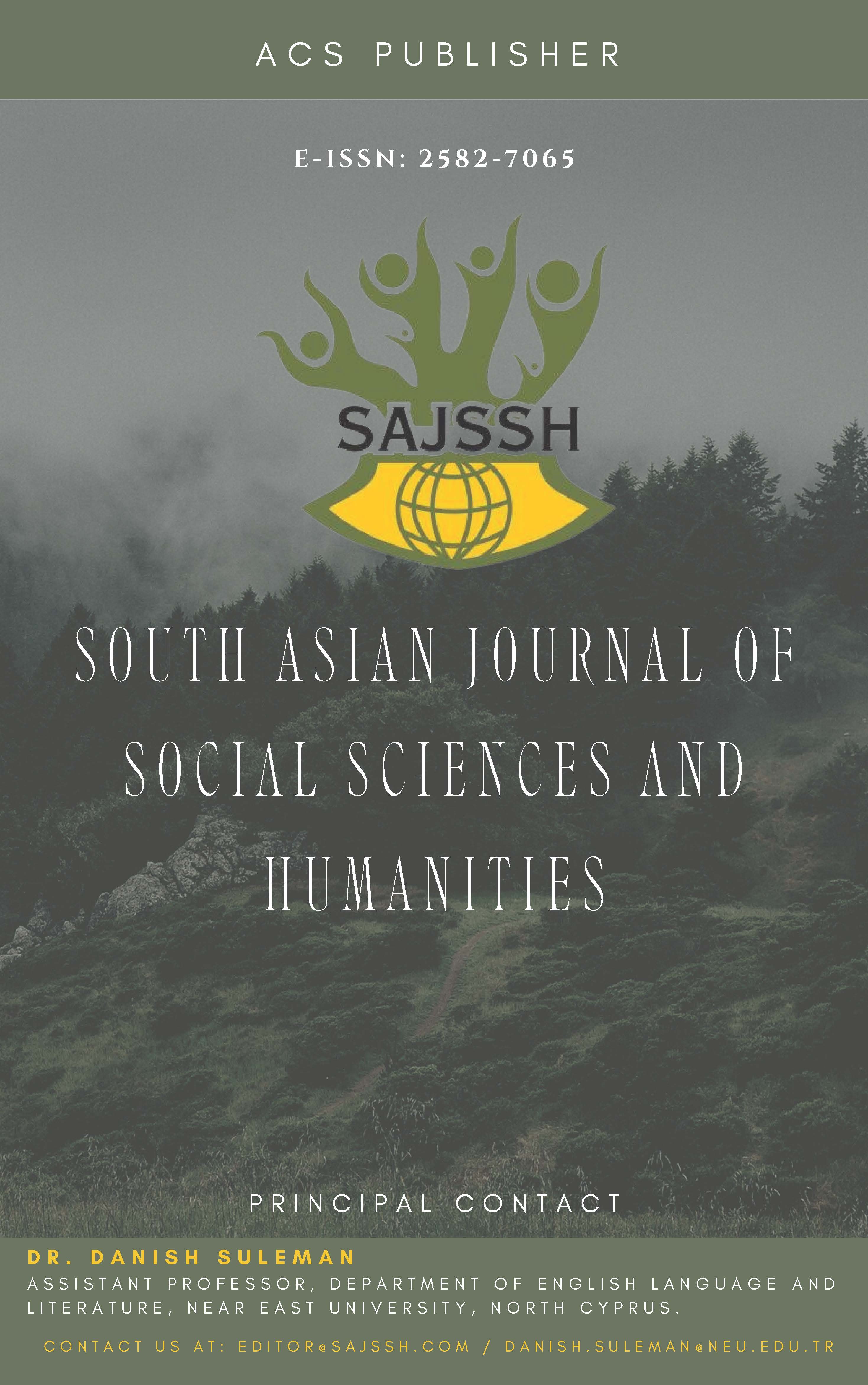Performance Indicators KPIs in Employee Performance Evaluation
DOI:
https://doi.org/10.48165/sajssh.2024.6203Keywords:
Performance Management, Key Performance Indicator, Employee Performance EvaluationAbstract
A current application of several studies drawn from the body of existing research is the Key Performance Indicator (KPI), which this article adds to. Scholarly publications from journals, books, and various other references that serve as sources of literature are used to exemplify the qualitative technique used in this article in order to produce a result. The authors present the implementation details for their research outcomes and recommendations in this scientific work while highlighting how human resource science spans multiple industries via its reliance on scientific literature publications. Other researchers must be able to carry out the findings of this scientific paper in the future due to the performance management gap that has not been fully explored in relation to the current Key Performance Indicators.References
Abdelhadi, A., Zainudin, S., & Sani, N. S. (2022). A regression model to predict key performance indicators in higher education enrollments. International Journal of Advanced Computer Science and Applications, 13(1), 454–460. https://doi.org/10.14569/IJACSA.2022.0130156
Al Dakheel, J., Del Pero, C., Aste, N., & Leonforte, F. (2020). Smart buildings features and key performance indicators: A review. Sustainable Cities and Society, 61, 102328. https://doi.org/10.1016/j.scs.2020.102328
Amstrong, M., & Baron, A. (2004). Performance management. Yogyakarta: Tugu Publisher. Anand, N., & Grover, N. (2015). Measuring retail supply chain performance: Theoretical model using key performance indicators (KPIs). Benchmarking, 22(1), 135–166. https://doi.org/10.1108/BIJ-05-2012-0034
De Jesus, N. M., & Buenas, L. J. E. (2023). Descriptive analytics and interactive visualizations for performance monitoring of extension services programs, projects, and activities. International Journal of Advanced Computer Science and Applications, 14(1), 660–668. https://doi.org/10.14569/IJACSA.2023.0140173
Del-Río-Ortega, A., Resinas, M., Cabanillas, C., & Ruiz-Cortés, A. (2013). On the definition and design-time analysis of process performance indicators. Information Systems, 38(4), 470–490. https://doi.org/10.1016/j.is.2012.11.004
Domínguez, E., Pérez, B., Rubio, Á. L., & Zapata, M. A. (2019). A taxonomy for key performance indicators management. Computer Standards and Interfaces, 64, 24–40. https://doi.org/10.1016/j.csi.2018.12.001
Heckl, D., & Moormann, J. (2010). Process performance management. Handbook on Business Process Management 2: Strategic Alignment, Governance, People and Culture, 115–135.
Joppen, R., von Enzberg, S., Gundlach, J., Kühn, A., & Dumitrescu, R. (2019). Key performance indicators in the production of the future. Procedia CIRP, 81(March), 759–764. https://doi.org/10.1016/j.procir.2019.03.190
Letrache, K., El Beggar, O., & Ramdani, M. (2016). Modeling and creating KPIs in MDA approach. Colloquium in Information Science and Technology, CIST, 0, 222–227. https://doi.org/10.1109/CIST.2016.7805046
Murtiningsih, R. S. (2019). The Impact of Compensation, Training &Development, and Organizational Culture on Job Satisfaction and employee Retention. Indonesian Management and Accounting Research, 19(1), 33–50. https://doi.org/10.25105/imar.v19i1.6969
Mangkunegara, A. P. (2017). Manajemen Sumber Daya Manusia. Remaja Rosda Karya.
Maté, A., Trujillo, J., & Mylopoulos, J. (2016). Key performance indicator elicitation and selection through conceptual modelling. Lecture Notes in Computer Science (Including Subseries Lecture Notes in Artificial Intelligence and Lecture Notes in Bioinformatics), 9974 LNCS, 73–80. https://doi.org/10.1007/978-3-319-46397-1_6
Mnif, S., Galoui, S., Elkosantini, S., Darmoul, S., & Ben Said, L. (2015). Ontology based
performance evaluation of public transport systems. 2015 4th IEEE International Conference on Advanced Logistics and Transport, IEEE ICALT 2015, 205–210. https://doi.org/10.1109/ICAdLT.2015.7136622
Mourtzis, D., Fotia, S., & Vlachou, E. (2016). PSS design evaluation via kpis and lean design assistance supported by context sensitivity tools. Procedia CIRP, 56, 496–501. https://doi.org/10.1016/j.procir.2016.10.097
Nursam, N. (2017). Manajemen Kinerja. Journal of Islamic Education Management, 2(2), 167–175. https://doi.org/10.24256/kelola.v2i2.438 Parmenter, D. (2015). Key performance indicators: developing, implementing, and using winning KPIs. John Wiley & Sons.
International Journal Of Digital Business Management, 4(3), 619–629. https://doi.org/10.31933/dijdbm.v4i2
Vegas, S., Juristo, N., & Basili, V. R. (2009). Maturing software engineering knowledge through classifications: A case study on unit testing techniques. IEEE Transactions on Software Engineering, 35(4), 551–565.
Velimirović, D., Velimirović, M., & Stanković, R. (2011). Role and importance of key performance indicators measurement. Serbian Journal of Management, 6(1), 63–72.
Vosoughi, S., Chalak, M. H., Yarahmadi, R., & Abolaghasemi, J. (2020). Identification, selection and prioritization of key performance indicators. 35–49.
Yuli Prastiani, Joko Sabtohadi, P. H. S. (2023). The influence of training and job placement on regional revenue agency employee performance in ast kutai district. Jurnal scientia, 12(3), 17–23.
Popova, V., & Sharpanskykh, A. (2010). Modeling organizational performance indicators. Information Systems, 35(4), 505–527. https://doi.org/10.1016/j.is.2009.12.001
Sabuhari, R., Sudiro, A., Irawanto, D. W., & Rahayu, M. (2020). The effects of human resource flexibility, employee competency, organizational culture adaptation and job satisfaction on employee performance. Management Science Letters, 10(8), 1777– 1786. https://doi.org/10.5267/j.msl.2020.1.001
Sasongko, S. R. (2022). Determinasi Kinerja Karyawan: Kompensasi, Pelatihan Dan Pengembangan (Suatu Kajian Studi Manajemen Sumberdaya Manusia). Jurnal Ilmu Manajemen Terapan, 3(6), 635–645. https://www.dinastirev.org/JIMT/article/view/891%0Ahttps://www.dinastirev.org/JIM
T/article/download /891/662
Sawitri, N. N., Susanto, P. C., & Suroso, S. (2023). Business Opportunity Human Resource Information System for a Human Resource Department to Create Career Path and Performance Evaluation. East Asian Journal of Multidisciplinary Research (EAJMR), 2(4), 1505–1516. https://doi.org/: https://doi.org/10.55927/eajmr.v2i4.3757 Schwartz, A. E. (1999). Performance management. Barron’s Educational Series.
Setyawati, A., Pahala, Y., & Susanto, P. C. (2022). Loading and unloading labor performance as a mediation of variables of work motivation , work competence and work behavior that impacts well- being loading and unloading labor. Journal of Economics, Management, Entrepreneur, and Business, 2(2), 146–161.
Sugiyono. (2018). Metode penelitian kuantitatif, kualitatif, dan metode penelitian kombinasi (Mixed Method). Alfabeta.
Susanto, P. C., Hidayat, W. W., Widyastuti, T., Transportasi, I., Jakarta, U. B., Keuangan, I., Asia, I., Author, C., & Candra, P. (2023). Analysis of resilience and competence on employee performance through intervening key performance indicator variables. Indonesian Journal of Business Analytics (IJBA), 3(3), 899–910. https://doi.org/https://doi.org/10.55927/ijba.v3i3.4274
Susanto, P. C., Sawitri, N. N., Ali, H., & Suroso, S. (2023). Performance management as a mediation of variable of competence and coaching skills that impacts organization sustainability. Formosa Journal of Multidisciplinary Research (FJMR), 2(4), 719– 728. https://doi.org/https://10.55927/fjmr.v2i4.3792
Susanto, P. C., Sawitri, N. N., & Susita, D. (2023). Job satisfaction and employee turnover : analysis recruitment , career development , organizational culture. Dinasti
Downloads
Published
Issue
Section
License
Copyright (c) 2025 South Asian Journal of Social Sciences and Humanities

This work is licensed under a Creative Commons Attribution 4.0 International License.





